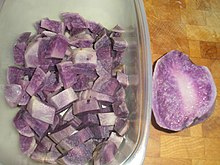
The potato is a starchy food, a tuber of the plant Solanum tuberosum and is a root vegetable native to the Americas. The plant is a perennial in the nightshade family Solanaceae.

The sweet potato or sweetpotato is a dicotyledonous plant that belongs to the bindweed or morning glory family, Convolvulaceae. Its large, starchy, sweet-tasting tuberous roots are used as a root vegetable. The young shoots and leaves are sometimes eaten as greens. Cultivars of the sweet potato have been bred to bear tubers with flesh and skin of various colors. Sweet potato is only distantly related to the common potato, both being in the order Solanales. Although darker sweet potatoes are often referred to as "yams" in parts of North America, the species is not a true yam, which are monocots in the order Dioscoreales.

Arracacia xanthorrhiza is a root vegetable that originates in the Andes, whose starchy taproot is a popular food item across South America where it is a major commercial crop.
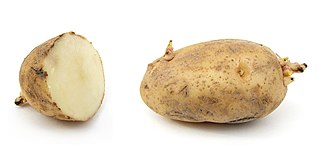
A russet potato is a type of potato that is large, with dark brown skin and few eyes. The flesh is white, dry, soft, and mealy, and it is suitable for baking, mashing, and french fries. Russet potatoes are also known as Idaho potatoes in the United States.

Russet Burbank is a potato cultivar with dark brown skin and few eyes that is the most widely grown potato in North America. A russet type, its flesh is white, dry, and mealy, and it is good for baking, mashing, and french fries (chips). It is a common and popular potato.

Yam is the common name for some plant species in the genus Dioscorea that form edible tubers. The tubers of some other species in the genus, such as D. communis, are toxic. Yams are perennial herbaceous vines cultivated for the consumption of their starchy tubers in many temperate and tropical regions, especially in West Africa, South America and the Caribbean, Asia, and Oceania. The tubers themselves, also called "yams", come in a variety of forms owing to numerous cultivars and related species.
Sheldon Farms is a family farm in the Battenk Kill Valley region of New York situated in Washington County in the town of Salem. The sixth-generation farm has been in operation since 1845. The farm is 600 acres (2.4 km2) in size situated on the Battenkill River and White Creek which are rich in minerals which contribute to the terroir of their produce. The farm utilizes 250 acres (1.0 km2) of its land for production.
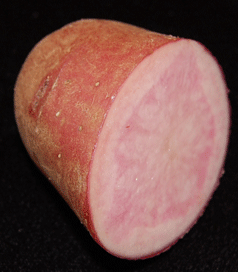
Adirondack Red is a potato variety with red flesh and skin, bred by Cornell University potato breeders Robert Plaisted, Ken Paddock and Walter De Jong, and released in 2004.

Red Norland is a red, early-maturing potato. Smaller tubers are commonly sold as “baby reds” and this variety is often served boiled or in potato salads. The progenitor variety, 'Norland', was released by the North Dakota Agricultural College in 1957. Since the release of 'Norland', other darker red skinned variants were selected, most notably 'Red Norland' and 'Dark Red Norland'. None of these three varieties is under plant variety protection. The darker red strains are now widely grown, and 'Norland' is rarely grown. 'Norland' and its selections are widely adapted, but have relatively low to intermediate yields.
Black Champion is a variety of potato with purple skin colour that produces round, flattened tubers. Davidson (1936) described this as an old variety found growing in the Midlands of Ireland but of no commercial value. Noted by Kehoe (1986) as being unique to the Irish potato collection.
Skerry Champion is a variety of potato with a round-to-oval shape and creamy yellow skin with a beautiful blue/purple "birthmark" colouring. 'Skerry Champions' have only recently become available to growers again after a long period of absence due to a host of viral diseases it was carrying. Taste quality is excellent with a lovely flavour and floury texture. They are quite highly resistant to blight however the tops of diseased haulms should be removed to keep tubers healthy. It has also been known as Buchan Beauty and although introduced into Ireland in 1922, may have existed in the UK before then.
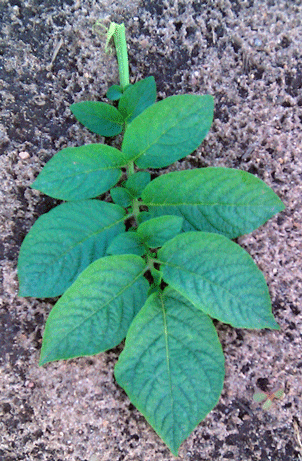
The Atlantic potato is a mid-season potato variety for potato chip manufacturing. It was developed and released by USDA Agricultural Research Service scientists at Beltsville, Maryland, in 1978. The variety is not under plant variety protection. It is a progeny of a cross between 'Wauseon' and 'Lenape'. It is widely grown for chipping directly off the field or with short-term storage. Marketable yields are fairly high.
Superior is a white-skinned, white-fleshed, mid-season potato variety. It was released by the University of Wisconsin potato breeding program in 1962, and is not under plant variety protection. It is a progeny of a cross between 'B96-56' and 'M59.44' and was first grown in 1951. 'B96-56' was also a parent of Kennebec. Like the potato variety Atlantic, Superior is widely grown for potato chip manufacturing right off the field and marketable yields are fairly high.
Umatilla Russet is a moderately late maturing variety of potato especially suitable for frozen french fries processing. It was jointly released by the Agricultural Experiment Station of Oregon, Idaho, and Washington and the U.S. Department of Agriculture in 1998. 'Umatilla Russet' has been equal to or better than Russet Burbank in fry color in Oregon and regional trials. The potato was named by the state of Oregon after the Umatilla tribe, from which the city of Umatilla also takes its name.
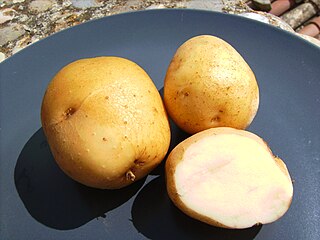
Kennebec is a medium- to late-maturing white potato. It was bred by the USDA and selected by Presque Isle Station, Maine, in 1941. Kennebec is not under plant variety protection. This fast-growing variety has high yields. It maintains good quality in storage and is grown for both fresh market use and for potato chip manufacturing.
The Villetta Rose is a late maturing red potato variety. It was developed at the University of Wisconsin-Madison and is under plant variety protection. It originated from a cross between Dark Red Norland and Nordonna varieties. 'Villetta Rose' has a medium to long dormancy, stores well and maintains its red color in storage. It is grown for fresh sale and processing including canning.
Marcy is a late maturing white potato variety. It was originally bred in 1990 at Cornell University from a cross between the Atlantic variety and Q155-3 variety. It is mostly used for chipping but can be used for baking and boiling. It has good storability; chip color is good even after short to medium storage. Marcy has a high yielding crop.

Tapioca chips are a snack food made from thin wafers of deep fried cassava root. It is commonly found in South India, Sri Lanka, as well as in Indonesia where it is known as kripik singkong and in Malaysia known as 'kerepek ubi'.
Fusarium dry rot is one of the most common potato diseases. It is caused by fungi in the genus Fusarium. This fungi causes a variety of colored rots in potatoes. This pathogen, while having both a sexual and asexual form, stays in an asexual cycle due to the way it spreads. Preferring warmer climates, it is not uncommon to find this pathogen in the northern United States where it has been reported to affect yield as much as 60%.
Pike is a variety of potato bred by the Cornell and Pennsylvania Experimental Stations in March 1996. This clone originated from a cross made in 1981, between 'Allegany' and 'Atlantic potato' varieties. It is resistant to infection by golden nematode, common scab, golden necrosis, and foliage infection by Phytophthora. Pike is intended to be used agriculturally, specifically for use in potato chips.
